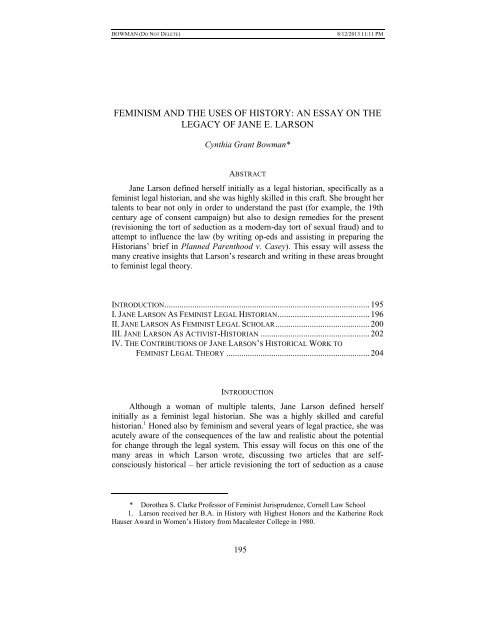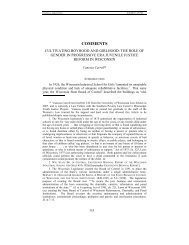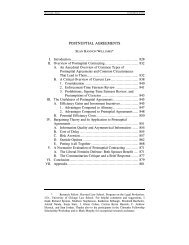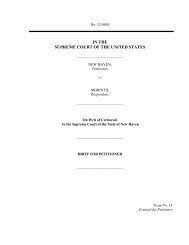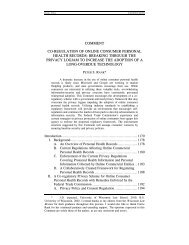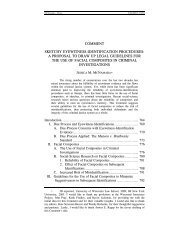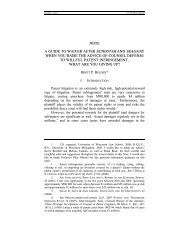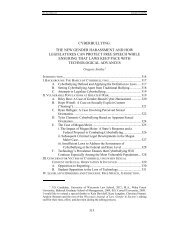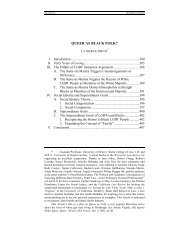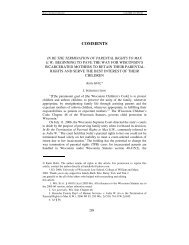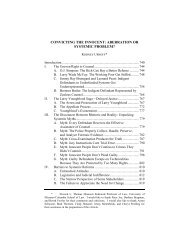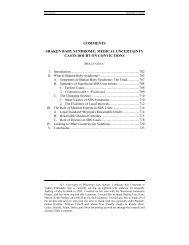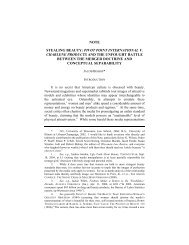An Essay on the Legacy of Jane E. Larson - UW Law School
An Essay on the Legacy of Jane E. Larson - UW Law School
An Essay on the Legacy of Jane E. Larson - UW Law School
Create successful ePaper yourself
Turn your PDF publications into a flip-book with our unique Google optimized e-Paper software.
BOWMAN (DO NOT DELETE)<br />
8/12/2013 11:11 PM<br />
FEMINISM AND THE USES OF HISTORY: AN ESSAY ON THE<br />
LEGACY OF JANE E. LARSON<br />
Cynthia Grant Bowman*<br />
ABSTRACT<br />
<strong>Jane</strong> Lars<strong>on</strong> defined herself initially as a legal historian, specifically as a<br />
feminist legal historian, and she was highly skilled in this craft. She brought her<br />
talents to bear not <strong>on</strong>ly in order to understand <strong>the</strong> past (for example, <strong>the</strong> 19th<br />
century age <strong>of</strong> c<strong>on</strong>sent campaign) but also to design remedies for <strong>the</strong> present<br />
(revisi<strong>on</strong>ing <strong>the</strong> tort <strong>of</strong> seducti<strong>on</strong> as a modern-day tort <strong>of</strong> sexual fraud) and to<br />
attempt to influence <strong>the</strong> law (by writing op-eds and assisting in preparing <strong>the</strong><br />
Historians’ brief in Planned Parenthood v. Casey). This essay will assess <strong>the</strong><br />
many creative insights that Lars<strong>on</strong>’s research and writing in <strong>the</strong>se areas brought<br />
to feminist legal <strong>the</strong>ory.<br />
INTRODUCTION ................................................................................................ 195<br />
I. JANE LARSON AS FEMINIST LEGAL HISTORIAN ........................................... 196<br />
II. JANE LARSON AS FEMINIST LEGAL SCHOLAR ............................................ 200<br />
III. JANE LARSON AS ACTIVIST-HISTORIAN ................................................... 202<br />
IV. THE CONTRIBUTIONS OF JANE LARSON’S HISTORICAL WORK TO<br />
FEMINIST LEGAL THEORY ................................................................... 204<br />
INTRODUCTION<br />
Although a woman <strong>of</strong> multiple talents, <strong>Jane</strong> Lars<strong>on</strong> defined herself<br />
initially as a feminist legal historian. She was a highly skilled and careful<br />
historian. 1 H<strong>on</strong>ed also by feminism and several years <strong>of</strong> legal practice, she was<br />
acutely aware <strong>of</strong> <strong>the</strong> c<strong>on</strong>sequences <strong>of</strong> <strong>the</strong> law and realistic about <strong>the</strong> potential<br />
for change through <strong>the</strong> legal system. This essay will focus <strong>on</strong> this <strong>on</strong>e <strong>of</strong> <strong>the</strong><br />
many areas in which Lars<strong>on</strong> wrote, discussing two articles that are selfc<strong>on</strong>sciously<br />
historical – her article revisi<strong>on</strong>ing <strong>the</strong> tort <strong>of</strong> seducti<strong>on</strong> as a cause<br />
* Doro<strong>the</strong>a S. Clarke Pr<strong>of</strong>essor <strong>of</strong> Feminist Jurisprudence, Cornell <strong>Law</strong> <strong>School</strong><br />
1. Lars<strong>on</strong> received her B.A. in History with Highest H<strong>on</strong>ors and <strong>the</strong> Ka<strong>the</strong>rine Rock<br />
Hauser Award in Women’s History from Macalester College in 1980.<br />
195
BOWMAN (DO NOT DELETE)<br />
8/12/2013 11:11 PM<br />
196 WISCONSIN JOURNAL OF LAW, GENDER & SOCIETY [Vol. 28:2<br />
<strong>of</strong> acti<strong>on</strong> for sexual fraud 2 and her piece about <strong>the</strong> nineteenth-century campaign<br />
to raise <strong>the</strong> age <strong>of</strong> c<strong>on</strong>sent to sex 3 —as well as her involvement in brief-writing<br />
as an historian and her many forays into <strong>the</strong> popular press.<br />
<strong>Jane</strong> Lars<strong>on</strong> brought her formidable talents to bear up<strong>on</strong> history not <strong>on</strong>ly<br />
in order to understand <strong>the</strong> past but also to design remedies for <strong>the</strong> present and<br />
attempt to influence <strong>the</strong> case law in <strong>the</strong> future. In Part I <strong>of</strong> this essay, I describe<br />
her most important historical research and discuss how it revised our<br />
understanding <strong>of</strong> <strong>the</strong> activism and legal reforms <strong>of</strong> nineteenth-century<br />
feminists, emphasizing its early timing, <strong>the</strong> breadth <strong>of</strong> subjects addressed,<br />
attitudes toward sexuality that were not c<strong>on</strong>fined to sex-repressive ideas, and<br />
<strong>the</strong> major areas <strong>of</strong> c<strong>on</strong>tinuity between <strong>the</strong> feminisms <strong>of</strong> <strong>the</strong> nineteenth and<br />
twentieth centuries. In Part II, I discuss Lars<strong>on</strong>’s related work as a legal<br />
scholar, a decidedly feminist <strong>on</strong>e, and in particular her attempts to design legal<br />
remedies for <strong>the</strong> present based <strong>on</strong> both her study <strong>of</strong> <strong>the</strong> past and insights from<br />
<strong>the</strong> developing field <strong>of</strong> feminist legal <strong>the</strong>ory. In Part III, I describe <strong>the</strong> various<br />
ways in which she brought history to bear up<strong>on</strong> <strong>the</strong> present, by writing about<br />
sexual fraud and o<strong>the</strong>r issues in <strong>the</strong> popular press, becoming an expert<br />
composer <strong>of</strong> op-eds, and working <strong>on</strong> <strong>the</strong> Historians’ briefs in important<br />
aborti<strong>on</strong> cases before <strong>the</strong> Supreme Court. Finally, in Part IV, I attempt to<br />
summarize some <strong>of</strong> <strong>the</strong> many creative insights that Lars<strong>on</strong>’s research and<br />
writing in <strong>the</strong>se areas brought to feminist legal <strong>the</strong>ory.<br />
I. JANE LARSON AS FEMINIST LEGAL HISTORIAN<br />
Lars<strong>on</strong>’s first major foray into feminist legal history resulted in a 100-<br />
page article <strong>on</strong> <strong>the</strong> tort <strong>of</strong> seducti<strong>on</strong> published in <strong>the</strong> Columbia <strong>Law</strong> Review in<br />
1993. 4 The article is so l<strong>on</strong>g not <strong>on</strong>ly because <strong>of</strong> <strong>the</strong> immense amount <strong>of</strong> legal<br />
research that went into it but also because legal and historical archives were not<br />
<strong>the</strong> <strong>on</strong>ly sources <strong>of</strong> data for its polymath author. In additi<strong>on</strong> to <strong>the</strong> case law and<br />
commentary, old and new, Lars<strong>on</strong> drew up<strong>on</strong> opera, literature, philosophy,<br />
political <strong>the</strong>ory, and popular culture, including nineteenth-century melodramas,<br />
to understand <strong>the</strong> meaning <strong>of</strong> seducti<strong>on</strong>. The c<strong>on</strong>clusi<strong>on</strong>s she drew were new in<br />
many ways, and spurred her to discuss legal reforms in <strong>the</strong> present as well as in<br />
<strong>the</strong> past.<br />
The first secti<strong>on</strong>s <strong>of</strong> <strong>the</strong> seducti<strong>on</strong> article described and dec<strong>on</strong>structed <strong>the</strong><br />
changing importance <strong>of</strong> <strong>the</strong> tort <strong>of</strong> seducti<strong>on</strong> in <strong>the</strong> nineteenth and early<br />
twentieth centuries. 5 Originally a cause <strong>of</strong> acti<strong>on</strong> brought by fa<strong>the</strong>rs for <strong>the</strong> loss<br />
<strong>of</strong> <strong>the</strong>ir daughters’ virginity, a total <strong>of</strong> 19 states codified <strong>the</strong> comm<strong>on</strong> law tort<br />
between 1846 and 1913 and also allowed <strong>the</strong> seduced woman to be <strong>the</strong><br />
2. <strong>Jane</strong> E. Lars<strong>on</strong>, “Women Understand so Little, They Call My Good Nature<br />
‘Deceit’”: A Feminist Rethinking <strong>of</strong> Seducti<strong>on</strong>, 93 COLUM. L. REV. 374 (1993) [hereinafter<br />
Rethinking <strong>of</strong> Seducti<strong>on</strong>].<br />
3. <strong>Jane</strong> E. Lars<strong>on</strong>, “Even A Worm Will Turn at Last”: Rape Reform in Late<br />
Nineteenth-Century America, 9 YALE J.L. & HUMAN. 1 (1997) [hereinafter Nineteenth-<br />
Century Rape Reform].<br />
4. Rethinking <strong>of</strong> Seducti<strong>on</strong>, supra note 2.<br />
5. Id. at 382
BOWMAN (DO NOT DELETE)<br />
8/12/2013 11:11 PM<br />
2013] FEMINISM AND THE USES OF HISTORY 197<br />
plaintiff. 6 At this point <strong>the</strong> cause <strong>of</strong> acti<strong>on</strong> was particularly useful for young<br />
working class women, who were especially vulnerable to sexual abuse in <strong>the</strong><br />
workplace; 7 it also provided middle class women with a type <strong>of</strong> female<br />
regulatory power over male sexual c<strong>on</strong>duct – <strong>on</strong>e that depended not up<strong>on</strong><br />
private beneficence or chivalry but up<strong>on</strong> <strong>the</strong> power <strong>of</strong> <strong>the</strong> state. 8 New attitudes<br />
toward sex current in <strong>the</strong> Progressive and New Deal eras, however, led<br />
feminists to reject <strong>the</strong> seducti<strong>on</strong> tort as a relic <strong>of</strong> Victorianism; <strong>the</strong>y joined with<br />
male activists, who emphasized <strong>the</strong> dangers <strong>of</strong> blackmail by scheming women,<br />
in <strong>the</strong> “anti-heart balm” movement that resulted in <strong>the</strong> aboliti<strong>on</strong> <strong>of</strong> this cause <strong>of</strong><br />
acti<strong>on</strong>, am<strong>on</strong>g o<strong>the</strong>rs such as breach <strong>of</strong> promise to marry, from 1935 <strong>on</strong>. 9<br />
Modern feminists inherited this interpretati<strong>on</strong> <strong>of</strong> <strong>the</strong> tort <strong>of</strong> seducti<strong>on</strong> as an<br />
outmoded, paternalistic, and puritanical legal acti<strong>on</strong>.<br />
<strong>Jane</strong> Lars<strong>on</strong>’s treatment <strong>of</strong> this area <strong>of</strong> law c<strong>on</strong>stituted a revisi<strong>on</strong> <strong>of</strong> much<br />
<strong>of</strong> <strong>the</strong> accepted historical wisdom about seducti<strong>on</strong>. It pushed back our<br />
understanding <strong>of</strong> when women’s legal reform efforts in <strong>the</strong> nineteenth century<br />
began. A decade before <strong>the</strong> suffrage movement commenced in Seneca Falls,<br />
women’s “moral reform” groups were active and succeeded in passing antiseducti<strong>on</strong><br />
laws in New York and Massachusetts. 10 Moreover, this movement<br />
was not, as almost universally understood, anti-sex; instead, its members<br />
recognized <strong>the</strong> c<strong>on</strong>necti<strong>on</strong>s am<strong>on</strong>g sexual exploitati<strong>on</strong>, paternalism, and <strong>the</strong><br />
status <strong>of</strong> women, and <strong>the</strong>y sought effective legal remedies that would give <strong>the</strong>m<br />
some measure <strong>of</strong> power over <strong>the</strong>ir lives. 11 Once women were able to sue <strong>on</strong><br />
<strong>the</strong>ir own behalf, <strong>the</strong> acti<strong>on</strong> became available, at least <strong>the</strong>oretically, to sexually<br />
active women as well as to those who were seduced as virgins. 12<br />
Lars<strong>on</strong>’s rehabilitati<strong>on</strong> <strong>of</strong> <strong>the</strong>se nineteenth century moral reformers was at<br />
<strong>the</strong> same time a realistic <strong>on</strong>e. The middle-class women who led <strong>the</strong> movement<br />
did not in fact envisage seducti<strong>on</strong> as a remedy for women who were “fallen” –<br />
for prostitutes, or immigrant and racial groups c<strong>on</strong>sidered to be naturally<br />
promiscuous. 13 <str<strong>on</strong>g>An</str<strong>on</strong>g>d working class women who were sexually active were<br />
unlikely to be rewarded with damages unless <strong>the</strong>y had suffered serious physical<br />
damage from being deceived into c<strong>on</strong>senting to sexual relati<strong>on</strong>s. 14<br />
Lars<strong>on</strong> c<strong>on</strong>tinued her explorati<strong>on</strong> <strong>of</strong> many <strong>of</strong> <strong>the</strong>se revisi<strong>on</strong>ist <strong>the</strong>mes in<br />
her 1997 article about <strong>the</strong> age <strong>of</strong> c<strong>on</strong>sent campaign, which was based up<strong>on</strong><br />
extensive archival research into <strong>the</strong> records <strong>of</strong> <strong>the</strong> Women’s Christian<br />
Temperance Uni<strong>on</strong> (WCTU) between 1885 and 1900, and especially records<br />
about <strong>the</strong> campaign to raise <strong>the</strong> age <strong>of</strong> c<strong>on</strong>sent in <strong>the</strong> District <strong>of</strong> Columbia. 15<br />
6. Id. at 382-87.<br />
7. Id. at 383-85.<br />
8. Id. at 390.<br />
9. Id. at 394-400.<br />
10. Rethinking <strong>of</strong> Seducti<strong>on</strong>, supra note 2, at 391.<br />
11. Id.<br />
12. Id. at 393.<br />
13. Id. at 390.<br />
14. Id. at 387.<br />
15. Nineteenth-Century Rape Reform, supra note 3, at 2-3. A cursory review <strong>of</strong> <strong>the</strong><br />
footnotes in this article reveals that Lars<strong>on</strong> reviewed <strong>the</strong> WCTU’s extensive notes <strong>on</strong>
BOWMAN (DO NOT DELETE)<br />
8/12/2013 11:11 PM<br />
198 WISCONSIN JOURNAL OF LAW, GENDER & SOCIETY [Vol. 28:2<br />
Often thought <strong>of</strong> as a group focused solely up<strong>on</strong> <strong>the</strong> prohibiti<strong>on</strong> <strong>of</strong> alcohol, <strong>the</strong><br />
WCTU was in fact a large nati<strong>on</strong>al mass women’s political organizati<strong>on</strong> with<br />
multiple goals, which became more explicitly feminist as time passed and its<br />
members experienced <strong>the</strong> resistance <strong>of</strong> male legislators to <strong>the</strong>ir demands. 16<br />
Indeed, to Frances Willard, its president, “temperance” was a wide net,<br />
including temperance in passi<strong>on</strong>s <strong>of</strong> all sorts. 17 The group sought broad-based<br />
reforms that would empower women, including in <strong>the</strong> sphere <strong>of</strong> employment<br />
and, <strong>of</strong> course, <strong>the</strong> right to vote. 18<br />
Lars<strong>on</strong>’s article focused <strong>on</strong> <strong>the</strong> WCTU’s campaign to raise <strong>the</strong> age <strong>of</strong><br />
c<strong>on</strong>sent to sex from as low as 10 years old in some states to 16 or 18 in state<br />
after state. Women who had not spoken in public before, lacked a vote, and had<br />
no previous political experience gave lectures, held mass meetings, went from<br />
door to door with petiti<strong>on</strong>s, wrote to legislators, solicited letters <strong>of</strong> support,<br />
encouraged <strong>the</strong> press to cover <strong>the</strong>ir issue, and organized mo<strong>the</strong>rs’ meetings to<br />
teach women how to educate <strong>the</strong>ir children (especially <strong>the</strong>ir boys) about sex<br />
and pers<strong>on</strong>al morality. 19 In an era when polite women did not talk about sex,<br />
<strong>the</strong>se women discussed incest, child sex abuse, rape, prostituti<strong>on</strong>, sexual<br />
harassment in <strong>the</strong> workplace, and <strong>the</strong> double standard <strong>of</strong> sexual c<strong>on</strong>duct for<br />
males and females, which <strong>the</strong>y blamed for many <strong>of</strong> <strong>the</strong>se moral ills. 20 By 1900,<br />
32 states had raised <strong>the</strong>ir age <strong>of</strong> c<strong>on</strong>sent to 16 or older. 21<br />
While <strong>the</strong> movement was a success in bringing about legal reform, Lars<strong>on</strong><br />
c<strong>on</strong>cluded, it was seriously lacking as an exercise <strong>of</strong> feminist politics. 22<br />
Although intended to attack <strong>the</strong> problem <strong>of</strong> rape, <strong>the</strong> new statutory rape laws<br />
protected <strong>on</strong>ly young women and girls; <strong>the</strong>y did nothing to extend protecti<strong>on</strong> to<br />
adult women. Moreover, law enforcement pers<strong>on</strong>nel and <strong>the</strong> judiciary made<br />
young victims prove <strong>the</strong>ir chastity and allowed mistake <strong>of</strong> age as a defense; and<br />
cases were brought by parents and prosecutors even in cases <strong>of</strong> truly c<strong>on</strong>sensual<br />
if underage sex. 23 Indeed, in <strong>the</strong> new era <strong>of</strong> <strong>the</strong> juvenile court, girls were<br />
adjudicated delinquent for underage sex. 24 While attempting to ally with<br />
women <strong>of</strong> o<strong>the</strong>r classes and even to empathize with “bad” women, <strong>the</strong> WCTU<br />
was also segregated; and Frances Willard openly shared <strong>the</strong> racism <strong>of</strong> many<br />
middle-class women <strong>of</strong> her time, leaving African American women to <strong>the</strong>ir<br />
own resources to deal with <strong>the</strong>ir pervasive exposure to sexual exploitati<strong>on</strong>. 25<br />
In telling, or retelling, this story, Lars<strong>on</strong> again provided important<br />
revisi<strong>on</strong>ist insights and c<strong>on</strong>firmed o<strong>the</strong>rs developed in her earlier article <strong>on</strong><br />
legislative debates as well as <strong>the</strong> voluminous literature published by this movement,<br />
including <strong>the</strong> WCTU nati<strong>on</strong>al newspaper, <strong>the</strong> Uni<strong>on</strong> Signal.<br />
16. Id. at 3-7, 28.<br />
17. Id. at 22-23.<br />
18. Id. at 28-29, 43-44.<br />
19. Id. at 38-41.<br />
20. Id. at 12-18, 27, 29-30.<br />
21. Id. at 37.<br />
22. Id. at 69.<br />
23. Nineteenth-Century Rape Reform, supra note 3, at 63-64.<br />
24. Id. at 65.<br />
25. Id. at 29-30, 45-52.
BOWMAN (DO NOT DELETE)<br />
8/12/2013 11:11 PM<br />
2013] FEMINISM AND THE USES OF HISTORY 199<br />
seducti<strong>on</strong>. She dem<strong>on</strong>strated, with plentiful evidence, that this mass movement<br />
<strong>of</strong> women in <strong>the</strong> nineteenth century was broad in scope and shared important<br />
c<strong>on</strong>tinuities with Sec<strong>on</strong>d Wave feminism. Although <strong>the</strong> issues <strong>of</strong> incest, child<br />
sex abuse, teen pregnancy, child prostituti<strong>on</strong>, sexual harassment, and<br />
n<strong>on</strong>c<strong>on</strong>sensual sex were rediscovered in <strong>the</strong> 1960s, it was certainly not <strong>the</strong> first<br />
time <strong>the</strong>y had been discussed. 26 The age <strong>of</strong> c<strong>on</strong>sent campaign was aimed at<br />
making it easier to prosecute all <strong>of</strong> <strong>the</strong>se <strong>of</strong>fenses, by doing an end-run around<br />
<strong>the</strong> defense <strong>of</strong> c<strong>on</strong>sent for women below a certain age and making sex with<br />
<strong>the</strong>m into a strict liability crime. 27<br />
Lars<strong>on</strong> also directly refuted <strong>the</strong> argument that <strong>the</strong> stories publicized by <strong>the</strong><br />
age <strong>of</strong> c<strong>on</strong>sent campaigners represented “seducti<strong>on</strong> narratives” – that is, myths<br />
propagated to reinforce c<strong>on</strong>servative values, scare respectable women away<br />
from sex, and police <strong>the</strong> sexuality <strong>of</strong> working class women. 28 Instead, Lars<strong>on</strong><br />
showed, <strong>the</strong>se stories were <strong>of</strong> real life forcible rapes, sexual abuse, incest, and<br />
workplace sexual harassment. 29<br />
Moreover, she attacked <strong>the</strong> comm<strong>on</strong> noti<strong>on</strong> <strong>of</strong> <strong>the</strong> age <strong>of</strong> c<strong>on</strong>sent<br />
movement, like that for remedies for seducti<strong>on</strong>, as pr<strong>of</strong>oundly anti-sex.<br />
Although very few <strong>of</strong> <strong>the</strong> reformers favored free love, <strong>the</strong>y did share a<br />
pr<strong>of</strong>ound understanding <strong>of</strong> sexuality under <strong>the</strong> prevailing social and political<br />
circumstances as an instrument <strong>of</strong> male power and female subordinati<strong>on</strong>, which<br />
<strong>the</strong> law supported by its lack <strong>of</strong> effective remedies for sexual assault; and <strong>the</strong>y<br />
aimed to disclose <strong>the</strong> dangerous truth underlying Victorian myths <strong>of</strong> family and<br />
male protecti<strong>on</strong> and alter male sexual behavior as a necessary c<strong>on</strong>diti<strong>on</strong> for <strong>the</strong><br />
advancement <strong>of</strong> women’s ec<strong>on</strong>omic and social status. 30<br />
Yet feminists involved in <strong>the</strong> anti-heart balm movement in <strong>the</strong> 1930’s and<br />
after, as well as later feminist legal <strong>the</strong>orists opposing gender-specific statutory<br />
rape laws (or statutory rape laws in general), interpreted <strong>the</strong> cause <strong>of</strong> acti<strong>on</strong><br />
sought by <strong>the</strong> WCTU as primarily c<strong>on</strong>servative and puritanical, committed to<br />
protecting women <strong>on</strong>ly if <strong>the</strong>y stayed in <strong>the</strong>ir proper, and asexual, place. 31 It is<br />
impossible to reach this simplistic c<strong>on</strong>clusi<strong>on</strong> after reading Lars<strong>on</strong>’s article <strong>on</strong><br />
<strong>the</strong> age <strong>of</strong> c<strong>on</strong>sent campaign, even if <strong>on</strong>e’s attitude toward statutory rape may<br />
remain c<strong>on</strong>flicted.<br />
Feminist history becomes smoo<strong>the</strong>r and more c<strong>on</strong>tinuous <strong>on</strong>ce this fuller<br />
knowledge is incorporated in it. Far from being cut <strong>of</strong>f from a First Wave <strong>of</strong><br />
feminism that focused increasingly narrowly up<strong>on</strong> suffrage and died <strong>of</strong><br />
exhausti<strong>on</strong> <strong>on</strong>ce that goal was attained, women <strong>of</strong> <strong>the</strong> Sec<strong>on</strong>d Wave were heirs<br />
to a rich and c<strong>on</strong>tinuous history <strong>of</strong> activism against rape and sexual abuse <strong>of</strong> all<br />
sorts, carried out by <strong>the</strong> great-grandmo<strong>the</strong>rs we all thought <strong>of</strong> as straitlaced in<br />
26. Id. at 5.<br />
27. Id. at 15, 19-20.<br />
28. See MARY E. ODEM, DELINQUENT DAUGHTERS: PROTECTING AND POLICING<br />
ADOLESCENT FEMALE SEXUALITY IN THE UNITED STATES, 1885-1920, at 4-5 (1995).<br />
29. See Nineteenth-Century Rape Reform, supra note 3, at 12-18.<br />
30. See, e.g., id. at 4-7.<br />
31. See, e.g., ODEM, supra note 26, at 16-17; M.B.W. Sinclair, Seducti<strong>on</strong> and <strong>the</strong><br />
Myth <strong>of</strong> <strong>the</strong> Ideal Woman, 5 LAW & INEQ. 33, 33, 90 (1987).
BOWMAN (DO NOT DELETE)<br />
8/12/2013 11:11 PM<br />
200 WISCONSIN JOURNAL OF LAW, GENDER & SOCIETY [Vol. 28:2<br />
mind as well as dress. Lars<strong>on</strong> also carried <strong>on</strong> <strong>the</strong>ir struggles in <strong>the</strong> c<strong>on</strong>text <strong>of</strong><br />
today.<br />
II. JANE LARSON AS FEMINIST LEGAL SCHOLAR<br />
Lars<strong>on</strong> was not c<strong>on</strong>tent to stop at an improved understanding <strong>of</strong> <strong>the</strong> past<br />
from a feminist perspective; her eye always remained <strong>on</strong> what could be d<strong>on</strong>e to<br />
benefit pers<strong>on</strong>s who were vulnerable today. She explained a good deal <strong>of</strong><br />
gender-based violence as rooted still in nineteenth-century noti<strong>on</strong>s <strong>of</strong> women as<br />
property, as objects ra<strong>the</strong>r than aut<strong>on</strong>omous sexual beings, and was eager to<br />
find ways to address this problem.<br />
As a legal scholar, this included her proposed tort <strong>of</strong> sexual fraud, a<br />
definiti<strong>on</strong> <strong>of</strong> which she suggested for inclusi<strong>on</strong> in <strong>the</strong> Restatement (Sec<strong>on</strong>d) <strong>of</strong><br />
Torts:<br />
One who fraudulently makes a misrepresentati<strong>on</strong> <strong>of</strong> fact, opini<strong>on</strong>,<br />
intenti<strong>on</strong>, or law, for <strong>the</strong> purpose <strong>of</strong> inducing ano<strong>the</strong>r to c<strong>on</strong>sent to<br />
sexual relati<strong>on</strong>s in reliance up<strong>on</strong> it, is subject to liability to <strong>the</strong> o<strong>the</strong>r<br />
in deceit for serious physical, pecuniary, and emoti<strong>on</strong>al loss caused<br />
to <strong>the</strong> recipient by his or her justifiable reliance up<strong>on</strong> <strong>the</strong><br />
misrepresentati<strong>on</strong>. 32<br />
The cause <strong>of</strong> acti<strong>on</strong> was carefully limited by <strong>the</strong> requirements that<br />
accompany any acti<strong>on</strong> for intenti<strong>on</strong>al misrepresentati<strong>on</strong>, such as in commercial<br />
transacti<strong>on</strong>s. First, <strong>the</strong> misrepresentati<strong>on</strong>, whe<strong>the</strong>r by words or o<strong>the</strong>r modes <strong>of</strong><br />
communicati<strong>on</strong>, must be intended to deceive ano<strong>the</strong>r party into c<strong>on</strong>senting to<br />
sex. Even silence could qualify as misrepresentati<strong>on</strong> where an affirmative duty<br />
to disclose arises by virtue <strong>of</strong> knowing about <strong>the</strong> reliant party’s special<br />
vulnerability. 33 Sec<strong>on</strong>d, <strong>the</strong> misrepresentati<strong>on</strong> must be <strong>of</strong> a material fact. In<br />
o<strong>the</strong>r words, <strong>the</strong> issue is whe<strong>the</strong>r reas<strong>on</strong>able pers<strong>on</strong>s would rely up<strong>on</strong> <strong>the</strong><br />
statement in deciding whe<strong>the</strong>r to c<strong>on</strong>sent to sex—such as claims that <strong>the</strong> pers<strong>on</strong><br />
seeking sex was unmarried, or sterile, free <strong>of</strong> sexually transmitted disease, or<br />
using c<strong>on</strong>tracepti<strong>on</strong>. 34 Third, <strong>of</strong> course, <strong>the</strong> o<strong>the</strong>r party must reas<strong>on</strong>ably rely<br />
up<strong>on</strong> <strong>the</strong> statement to her (or his) detriment. Finally, unlike <strong>the</strong> few cases that<br />
had already been decided under a similar cause <strong>of</strong> acti<strong>on</strong>, <strong>the</strong> harms to be<br />
compensated included not just physical and ec<strong>on</strong>omic loss but also emoti<strong>on</strong>al<br />
harm, which was in many ways <strong>the</strong> more foreseeable type <strong>of</strong> damage. 35 <str<strong>on</strong>g>An</str<strong>on</strong>g>d,<br />
<strong>the</strong> judgment was to be made under a reas<strong>on</strong>able victim or reas<strong>on</strong>able woman<br />
standard. 36<br />
What was required – and what Lars<strong>on</strong> was seeking to initiate – was quite<br />
simply to revise comm<strong>on</strong> expectati<strong>on</strong>s about sex – <strong>the</strong> rules <strong>of</strong> <strong>the</strong> game – to<br />
32. Rethinking <strong>of</strong> Seducti<strong>on</strong>, supra note 2, at 453.<br />
33. Id. at 456-58.<br />
34. Id. at 462-67.<br />
35. Id. at 459-61.<br />
36. Id. at 468-71.
BOWMAN (DO NOT DELETE)<br />
8/12/2013 11:11 PM<br />
2013] FEMINISM AND THE USES OF HISTORY 201<br />
“craft[] a sexually n<strong>on</strong>-repressive, yet interventi<strong>on</strong>ist, regime <strong>of</strong> sexual<br />
regulati<strong>on</strong> in <strong>the</strong> interests <strong>of</strong> women.” 37 From <strong>the</strong> point <strong>of</strong> view <strong>of</strong> everyday<br />
sexual interacti<strong>on</strong>s, this would require that any would-be deceiver must<br />
c<strong>on</strong>sider in advance what kind <strong>of</strong> reliance his or her words and/or c<strong>on</strong>duct will<br />
likely create, and to do so from <strong>the</strong> perspective <strong>of</strong> <strong>the</strong> pers<strong>on</strong> to whom <strong>the</strong>y are<br />
addressed. 38 In a world <strong>of</strong> equality between males and females comfortable<br />
with <strong>the</strong>ir sexuality, this would amount to a substantial change in <strong>the</strong> c<strong>on</strong>cept <strong>of</strong><br />
c<strong>on</strong>sent to sex, based <strong>on</strong> “a coherent normative <strong>the</strong>ory <strong>of</strong> <strong>the</strong> mutual obligati<strong>on</strong>s<br />
to be shared by equal sexual partners.” 39<br />
The popular media went wild at this clearly unreas<strong>on</strong>able, if not lunatic,<br />
suggesti<strong>on</strong>. Lars<strong>on</strong>’s picture was <strong>on</strong> <strong>the</strong> fr<strong>on</strong>t page <strong>of</strong> <strong>the</strong> Wall Street Journal,<br />
and <strong>the</strong>re were articles about her proposal in magazines ranging from Glamour<br />
to Playboy. 40 A columnist at Playboy called <strong>the</strong> tort <strong>of</strong> seducti<strong>on</strong> “unfair to<br />
men,” and Camille Paglia called it “craziness” and “a wild excess <strong>of</strong> feminist<br />
puritanism,” asking “D<strong>on</strong>’t <strong>the</strong>se feminists know that everything in romance is<br />
lying and delusi<strong>on</strong>?” 41 Lars<strong>on</strong> resp<strong>on</strong>ded simply that “The law <strong>of</strong> <strong>the</strong> jungle<br />
should not apply to sexual relati<strong>on</strong>ships.” 42 Her own opini<strong>on</strong>, expressed in <strong>the</strong><br />
Columbia <strong>Law</strong> Review article, was that equality and openness in sexual<br />
relati<strong>on</strong>ships would in fact lead to more satisfying, and probably more, sex. 43<br />
The uproar in <strong>the</strong> press put Lars<strong>on</strong>’s <strong>the</strong>ory very much in <strong>the</strong> public eye,<br />
leading to radio and televisi<strong>on</strong> appearances and provoking debate am<strong>on</strong>g an<br />
audience much broader than usual for articles published in academic journals –<br />
precisely <strong>the</strong> intended effect <strong>of</strong> her proposal.<br />
Far from being afraid <strong>of</strong> bringing <strong>the</strong> government into <strong>the</strong> bedroom,<br />
Lars<strong>on</strong> took a stand in favor <strong>of</strong> interventi<strong>on</strong>ist feminism, that is, appealing to<br />
<strong>the</strong> power <strong>of</strong> <strong>the</strong> state to remedy inequalities and injustices in <strong>the</strong> heret<strong>of</strong>ore<br />
private sphere. 44 Here she parted company from many liberals, and definitely<br />
with both sexual libertarian and postmodern feminists, retorting that <strong>the</strong> <strong>on</strong>ly<br />
alternative was “to cede governance <strong>of</strong> that sphere to private regimes <strong>of</strong><br />
power,” which were stacked against women. 45 Lars<strong>on</strong>, though developing her<br />
37. Id. at 381.<br />
38. Rethinking <strong>of</strong> Seducti<strong>on</strong>, supra note 2, at 469.<br />
39. Id. at 411.<br />
40. See Ellen Joan Pollock, As Remedy for Certain Broken Promises, Pr<strong>of</strong>essor<br />
Proposes ‘Sexual Fraud’ Suits, WALL ST. J., June 11, 1993, at B1; Should <strong>the</strong> <strong>Law</strong> Punish<br />
Lovers Who Lie?, GLAMOUR, April 1994, at 133; Ted C. Fishman, The <strong>Law</strong> & Love: When<br />
Brokenhearted Lovers Hire Attorneys, PLAYBOY, Aug. 1, 1994, at 46. This caused Lars<strong>on</strong>’s<br />
<strong>the</strong>n dean, who was also this author’s dean, to call her his “rock star.”<br />
41. See Shulamith Gold, D<strong>on</strong> Juan in Court: Would Reviving Seducti<strong>on</strong> Suits Keep<br />
Lovers H<strong>on</strong>est?, CHI. TRIB., Jan. 5, 1993 (Tempo sec.), at 1.<br />
42. Id.<br />
43. Rethinking <strong>of</strong> Seducti<strong>on</strong>, supra note 2, at 438.<br />
44. Id. at 430-44.<br />
45. Id. at 439.
BOWMAN (DO NOT DELETE)<br />
8/12/2013 11:11 PM<br />
202 WISCONSIN JOURNAL OF LAW, GENDER & SOCIETY [Vol. 28:2<br />
own unique body <strong>of</strong> research and <strong>the</strong>ory, remained an especially adept student<br />
<strong>of</strong> Catharine MacKinn<strong>on</strong>. 46<br />
Lars<strong>on</strong>’s c<strong>on</strong>tributi<strong>on</strong> to <strong>the</strong> feminist legal <strong>the</strong>ory <strong>of</strong> sex developed<br />
creatively up<strong>on</strong> that <strong>of</strong> her mentor. As she stated upfr<strong>on</strong>t in <strong>the</strong> seducti<strong>on</strong><br />
article, her goal was to design a <strong>the</strong>ory that “challenges <strong>the</strong> adversarial image <strong>of</strong><br />
sexual relati<strong>on</strong>s between women and men that currently prevails in <strong>the</strong> law, and<br />
counterposes a model <strong>of</strong> mutuality and reciprocity in <strong>the</strong> form <strong>of</strong> a minimal<br />
obligati<strong>on</strong> to deal fairly and h<strong>on</strong>estly with a sexual partner.” 47 This was an<br />
ambitious project indeed, and a goal Lars<strong>on</strong> developed fur<strong>the</strong>r, and arguably<br />
accomplished, in her collaborati<strong>on</strong> with Linda Hirshman <strong>on</strong> <strong>the</strong>ir book Hard<br />
Bargains: The Politics <strong>of</strong> Sex, published by Oxford University Press in 1998.<br />
III. JANE LARSON AS ACTIVIST-HISTORIAN<br />
Lars<strong>on</strong> was not c<strong>on</strong>tent to disseminate her ideas <strong>on</strong>ly in law reviews and<br />
workshops for law faculty. As noted, she was eager to comment in outlets more<br />
likely to reach a larger audience. As part <strong>of</strong> this determinati<strong>on</strong>, she became<br />
especially adept at <strong>the</strong> art <strong>of</strong> writing op-ed articles, a particularly difficult skill<br />
for an academic used to having more than 700 to 800 words in which to make a<br />
complex point. Lars<strong>on</strong> was terrific at it. She could turn out an op-ed in a few<br />
hours, and her talents quickly became in demand. She made her points in a few<br />
pithy phrases. Here, for example, is <strong>the</strong> c<strong>on</strong>clusi<strong>on</strong> to <strong>on</strong>e piece about her<br />
proposal for a tort <strong>of</strong> sexual fraud:<br />
When we as a society set ground rules for sexual relati<strong>on</strong>s – no force, no<br />
threats, no unc<strong>on</strong>sented-to touch, no “sexual shakedown” <strong>on</strong> your job, no<br />
exploitati<strong>on</strong> <strong>of</strong> children, and now no fraud – we’re not legislating <strong>the</strong> heart.<br />
We’re legislating intenti<strong>on</strong>al c<strong>on</strong>duct. Not feelings. Not desires. But knowing<br />
and intenti<strong>on</strong>al c<strong>on</strong>duct with serious social c<strong>on</strong>sequences. There isn’t any<br />
reas<strong>on</strong> to place special legal obstacles in <strong>the</strong> path <strong>of</strong> innocent victims <strong>of</strong> sexual<br />
fraud. 48<br />
Lars<strong>on</strong> wrote op-eds <strong>on</strong> a wide variety <strong>of</strong> subjects, not just based <strong>on</strong><br />
history and law, but all <strong>of</strong> <strong>the</strong>m having to do with persuading <strong>the</strong> public about<br />
issues <strong>of</strong> injustice, especially to women and o<strong>the</strong>r vulnerable groups. She<br />
wrote, for example, to urge <strong>the</strong> appointment <strong>of</strong> more women to <strong>the</strong> federal<br />
courts at a time when <strong>the</strong>re were virtually n<strong>on</strong>e <strong>on</strong> that bench in Nor<strong>the</strong>rn<br />
Illinois. 49 With co-author J<strong>on</strong>athan Knee, she wrote about remedies for victims<br />
<strong>of</strong> sexual harassment and to oppose weakening hate-law crimes. 50 <str<strong>on</strong>g>An</str<strong>on</strong>g>d with<br />
46. Pr<strong>of</strong>essor Catharine A. MacKinn<strong>on</strong> taught <strong>Jane</strong> Lars<strong>on</strong> at <strong>the</strong> University <strong>of</strong><br />
Minnesota <strong>Law</strong> <strong>School</strong> in <strong>the</strong> mid-1980’s.<br />
47. Rethinking <strong>of</strong> Seducti<strong>on</strong>, supra note 2, at 380.<br />
48. <strong>Jane</strong> E. Lars<strong>on</strong>, Sex, Lies and <strong>the</strong> Right to Sue, CHI. TRIB., Oct. 5, 1993<br />
(Perspective Sec.), at 19.<br />
49. See Cynthia Grant Bowman & <strong>Jane</strong> E. Lars<strong>on</strong>, Op-Ed, Where Equity Is Still Only<br />
a Shadow, CHI. TRIB., May 5, 1994 (Perspective Sec.), at 31.<br />
50. <strong>Jane</strong> E. Lars<strong>on</strong> & J<strong>on</strong>athan A. Knee, D<strong>on</strong>’t Weaken Hate-Crime <strong>Law</strong>s, CHI. TRIB.,<br />
Feb. 5, 1993 (Perspective Sec.), at 23; <strong>Jane</strong> E. Lars<strong>on</strong> & J<strong>on</strong>athan A. Knee, We Can Do<br />
Something About Sexual Harassment, WASH. POST, Oct. 22, 1991, at A21; J<strong>on</strong>athan A. Knee
BOWMAN (DO NOT DELETE)<br />
8/12/2013 11:11 PM<br />
2013] FEMINISM AND THE USES OF HISTORY 203<br />
Linda Hirshman, she wrote simply, directly, and persuasively about hostile<br />
envir<strong>on</strong>ment sexual harassment claims as a cause <strong>of</strong> acti<strong>on</strong> for sex<br />
discriminati<strong>on</strong> in employment. 51<br />
Lars<strong>on</strong> also became involved in more direct attempts to influence <strong>the</strong> law,<br />
by c<strong>on</strong>tributing to <strong>the</strong> preparati<strong>on</strong> <strong>of</strong> amicus curiae briefs <strong>on</strong> issues <strong>of</strong><br />
importance to women before <strong>the</strong> Supreme Court. With Sylvia <strong>Law</strong> and Clyde<br />
Spillenger, she helped prepare <strong>the</strong> “Historians’ briefs” filed in <strong>the</strong> Webster and<br />
Casey cases, when <strong>the</strong> right to aborti<strong>on</strong> outlined in Roe v. Wade hung in <strong>the</strong><br />
balance. 52 These briefs presented an account <strong>of</strong> <strong>the</strong> history <strong>of</strong> aborti<strong>on</strong> in <strong>the</strong><br />
United States as widely accepted, punished at most as a comm<strong>on</strong> law<br />
misdemeanor, until <strong>the</strong> campaign <strong>of</strong> <strong>the</strong> American Medical Associati<strong>on</strong> in <strong>the</strong><br />
mid- to late 1800’s, which was intended to drive out midwives and<br />
pr<strong>of</strong>essi<strong>on</strong>alize <strong>the</strong> practice <strong>of</strong> medicine; <strong>the</strong> AMA appealed to racist, nativist,<br />
and sex discriminatory arguments in support <strong>of</strong> its argument. These briefs<br />
evoked c<strong>on</strong>troversy am<strong>on</strong>g historians, some <strong>of</strong> whom argued that <strong>the</strong>y were<br />
essentially political documents and not reputable history. 53<br />
Lars<strong>on</strong> and Spillenger resp<strong>on</strong>ded to <strong>the</strong>se criticisms in a 1990 article in<br />
The Public Historian. 54 They first explained <strong>the</strong> advocacy-based goals <strong>of</strong> <strong>the</strong><br />
Webster brief – “to make it impossible for <strong>the</strong> Court to employ an argument<br />
that throughout this nati<strong>on</strong>’s history aborti<strong>on</strong> had been ei<strong>the</strong>r uniformly<br />
c<strong>on</strong>demned in law or avoided in practice.” 55 After adverting to <strong>the</strong> social<br />
c<strong>on</strong>structi<strong>on</strong> <strong>of</strong> all knowledge, <strong>the</strong>y went <strong>on</strong> to discuss <strong>the</strong> standards <strong>of</strong><br />
historical scholarship in <strong>the</strong> academy and to c<strong>on</strong>trast <strong>the</strong>m with <strong>the</strong><br />
requirements <strong>of</strong> legal advocacy within <strong>the</strong> c<strong>on</strong>straints and in <strong>the</strong> form <strong>of</strong> a brief.<br />
Historical scholarship emphasizes complexity and <strong>the</strong> c<strong>on</strong>fr<strong>on</strong>tati<strong>on</strong> <strong>of</strong><br />
c<strong>on</strong>flicting views <strong>of</strong> <strong>the</strong> truth, <strong>the</strong>y said, and reflects “a desire for order and<br />
c<strong>on</strong>sensus over c<strong>on</strong>flict and c<strong>on</strong>fr<strong>on</strong>tati<strong>on</strong>,” which leads to centrist positi<strong>on</strong>s. 56<br />
Legal argument, by c<strong>on</strong>trast, is embodied in forceful, n<strong>on</strong>-tentative language<br />
and is subject to severe limitati<strong>on</strong>s <strong>of</strong> length and form. 57 In <strong>the</strong> Historians’<br />
Brief, this resulted in <strong>the</strong> omissi<strong>on</strong> from <strong>the</strong> brief <strong>of</strong> <strong>the</strong> fact that nineteenthcentury<br />
feminist leaders supported regulati<strong>on</strong> or prohibiti<strong>on</strong> <strong>of</strong> aborti<strong>on</strong> (and,<br />
& <strong>Jane</strong> E. Lars<strong>on</strong>, The Wr<strong>on</strong>g in Dole’s “Rights” Bill, CHI. TRIB., Apr. 17, 1991 (Perspective<br />
sec.), at 19.<br />
51. Linda R. Hirshman & <strong>Jane</strong> E. Lars<strong>on</strong>, Through <strong>the</strong> Courts, Up <strong>the</strong> Ladder: How<br />
Much Must a Woman Put Up With?, CHI. TRIB., Nov. 17, 1993 (Perspective sec.), at 21.<br />
52. Brief <strong>of</strong> 250 American Historians, et al. as Amici Curiae in Support <strong>of</strong> Planned<br />
Parenthood <strong>of</strong> Sou<strong>the</strong>astern Pennsylvania, Planned Parenthood <strong>of</strong> Sou<strong>the</strong>astern Pennsylvania<br />
v. Casey, 505 U.S. 833 (1992) (Nos. 91-744 and 91-902). Brief <strong>of</strong> 281 American Historians<br />
et al. as Amici Curiae Supporting Appellees, Webster v. Reproductive Health Services, 492<br />
U.S. 490 (1989) (No. 88-605).<br />
53. See <strong>Jane</strong> E. Lars<strong>on</strong> & Clyde Spillenger, “That’s Not History”: The Boundaries <strong>of</strong><br />
Advocacy and Scholarship, 12 THE PUBLIC HISTORIAN 33, 33 n. 3 (1990).<br />
54. Id. at 33.<br />
55. Id. at 35.<br />
56. Id. at 39, 41.<br />
57. Id. at 39-42.
BOWMAN (DO NOT DELETE)<br />
8/12/2013 11:11 PM<br />
204 WISCONSIN JOURNAL OF LAW, GENDER & SOCIETY [Vol. 28:2<br />
indeed, <strong>of</strong> birth c<strong>on</strong>trol). 58 Although it was possible to explain this oppositi<strong>on</strong><br />
without fatally undermining <strong>the</strong> brief’s argument, <strong>the</strong>re was not enough space<br />
to do so.<br />
This omissi<strong>on</strong> left <strong>the</strong> Historians’ Brief open to attacks based <strong>on</strong> <strong>the</strong><br />
writings <strong>of</strong> respected early feminists, which featured in <strong>the</strong> brief filed by <strong>the</strong><br />
Feminists for Life. 59 While accepting <strong>the</strong>ir criticism, Lars<strong>on</strong> and Spillenger<br />
argued that historians must not renounce <strong>the</strong>ir public resp<strong>on</strong>sibility by insisting<br />
<strong>on</strong> importing <strong>the</strong> standards <strong>of</strong> historical complexity into historically-based<br />
advocacy. “The ‘knowledge pr<strong>of</strong>essi<strong>on</strong>s,’” <strong>the</strong>y c<strong>on</strong>cluded, “must be prepared<br />
to translate <strong>the</strong>ir understandings into <strong>the</strong> less rarefied language <strong>of</strong> politics<br />
where those understandings have c<strong>on</strong>sequences for power.” 60 It is not easy to<br />
walk <strong>the</strong> line between adherence to high standards <strong>of</strong> historical scholarship,<br />
while at <strong>the</strong> same time entering <strong>the</strong> arenas <strong>of</strong> power and using historical data to<br />
influence decisi<strong>on</strong>s with serious impact <strong>on</strong> <strong>the</strong> lives <strong>of</strong> women. Yet <strong>Jane</strong> Lars<strong>on</strong><br />
str<strong>on</strong>gly felt <strong>the</strong> obligati<strong>on</strong> to do so, and it was a resp<strong>on</strong>sibility she did not<br />
shirk.<br />
At <strong>the</strong> same time, Lars<strong>on</strong> was not naïve about <strong>the</strong> chances that her<br />
liberatory noti<strong>on</strong>s <strong>of</strong> sexuality and reproductive freedom would be realized in<br />
<strong>the</strong> immediate future. She understood that it was unlikely that her proposed tort<br />
<strong>of</strong> sexual fraud would be incorporated into <strong>the</strong> next editi<strong>on</strong> <strong>of</strong> <strong>the</strong> Restatement<br />
<strong>of</strong> Torts or, if it were adopted, that deeply ingrained patterns <strong>of</strong> sexual<br />
interacti<strong>on</strong> would change very so<strong>on</strong>. But she c<strong>on</strong>tinued to insist up<strong>on</strong> <strong>the</strong> power<br />
<strong>of</strong> what she called “<strong>the</strong> effects <strong>of</strong> even wholly symbolic legal reform<br />
victories.” 61 Although raising <strong>the</strong> age <strong>of</strong> c<strong>on</strong>sent to sex had not c<strong>on</strong>quered <strong>the</strong><br />
problems <strong>of</strong> child sexual abuse, incest, and abuse <strong>of</strong> authority over <strong>the</strong> young,<br />
she c<strong>on</strong>cluded, “such laws do express <strong>the</strong> moral expectati<strong>on</strong> that adults will<br />
accept resp<strong>on</strong>sibility to protect <strong>the</strong> young from sexual violence, abuse, and<br />
overreaching, even at <strong>the</strong> expense <strong>of</strong> <strong>the</strong>ir own sexual liberty.” 62 <str<strong>on</strong>g>An</str<strong>on</strong>g>d that was<br />
worth <strong>the</strong> investment <strong>of</strong> her labor and her passi<strong>on</strong>.<br />
IV. THE CONTRIBUTIONS OF JANE LARSON’S HISTORICAL WORK TO FEMINIST<br />
LEGAL THEORY<br />
One way to measure <strong>the</strong> influence <strong>of</strong> a scholar like <strong>Jane</strong> Lars<strong>on</strong> is to<br />
examine how <strong>the</strong> c<strong>on</strong>versati<strong>on</strong> about <strong>the</strong> subjects up<strong>on</strong> which she wrote was<br />
different after her articles were published than before. In <strong>on</strong>e article published<br />
in 1987, for example, its law pr<strong>of</strong>essor author stated that “As twentieth century<br />
women achieved a measure <strong>of</strong> sexual aut<strong>on</strong>omy, <strong>the</strong> tort <strong>of</strong> seducti<strong>on</strong> became<br />
58. Id. at 39. On <strong>the</strong> attitude <strong>of</strong> nineteenth-century feminists to birth c<strong>on</strong>trol, see<br />
LINDA GORDON, THE MORAL PROPERTY OF WOMEN: A HISTORY OF BIRTH CONTROL POLITICS<br />
IN AMERICA 57-67 (rev. ed. 2002).<br />
59. See, e.g., Brief <strong>of</strong> Feminists for Life <strong>of</strong> America, Pr<strong>of</strong>essi<strong>on</strong>al Women’s Network,<br />
et al., as Amicus Curiae in Support <strong>of</strong> Petiti<strong>on</strong>ers, Bray v. Alexandria Women’s Health<br />
Clinic, 506 U.S. 263 (1993) (No. 90-985).<br />
60. Lars<strong>on</strong> & Spillenger, supra note 53, at 43.<br />
61. Nineteenth-Century Rape Reform, supra note 3, at 71.<br />
62. Id.
BOWMAN (DO NOT DELETE)<br />
8/12/2013 11:11 PM<br />
2013] FEMINISM AND THE USES OF HISTORY 205<br />
‘as musty and out-<strong>of</strong>-date as Tennys<strong>on</strong>’s “Lady <strong>of</strong> Shalott.”’. . . Today <strong>the</strong> tort<br />
seems moribund” and that “The sexually aut<strong>on</strong>omous woman brooks no such<br />
patr<strong>on</strong>izing.” 63 In o<strong>the</strong>r words, <strong>the</strong> seducti<strong>on</strong> tort had no place in a world <strong>of</strong> sex<br />
equality in <strong>the</strong> opini<strong>on</strong> <strong>of</strong> this author. 64 By c<strong>on</strong>trast, scholars writing subsequent<br />
to <strong>the</strong> publicati<strong>on</strong> <strong>of</strong> Lars<strong>on</strong>’s 1993 Columbia article resp<strong>on</strong>ded to her “call for<br />
a more positive appraisal <strong>of</strong> 19 th -century sex reform and its legislative<br />
outcomes” in this area. 65 No <strong>on</strong>e could write about <strong>the</strong> tort <strong>of</strong> seducti<strong>on</strong> today<br />
without taking <strong>Jane</strong>’s c<strong>on</strong>tributi<strong>on</strong> into account.<br />
A very rough measure <strong>of</strong> <strong>the</strong> influence <strong>of</strong> a scholarly article may be<br />
provided by a citati<strong>on</strong> count. Lars<strong>on</strong>’s seducti<strong>on</strong> article has been cited by at<br />
least 108 subsequent authors. 66 Perhaps more important to her law reform<br />
goals, it has also been read by judges and <strong>the</strong>ir clerks, having been cited by <strong>on</strong>e<br />
federal court <strong>of</strong> appeals <strong>on</strong> two occasi<strong>on</strong>s, <strong>on</strong>e federal district court, <strong>the</strong><br />
Supreme Court <strong>of</strong> Georgia, and appellate courts in New York, Massachusetts,<br />
and California. 67 <strong>Jane</strong> Lars<strong>on</strong>’s legacy will undoubtedly c<strong>on</strong>tinue to inform<br />
scholarship <strong>on</strong> feminist legal history and <strong>on</strong> <strong>the</strong> regulati<strong>on</strong> <strong>of</strong> sexuality in <strong>the</strong><br />
future.<br />
I am not equal to summing up Lars<strong>on</strong>’s c<strong>on</strong>tributi<strong>on</strong> to feminist legal<br />
<strong>the</strong>ory in general — or even <strong>on</strong> <strong>the</strong> particular subjects <strong>of</strong> this essay. What I can<br />
describe, though, are a few <strong>of</strong> <strong>the</strong> things I, as <strong>on</strong>e feminist legal <strong>the</strong>orist,<br />
learned from <strong>Jane</strong> Lars<strong>on</strong> – both from reading her work and from pers<strong>on</strong>al<br />
interacti<strong>on</strong>s with her as a colleague. I learned to take nothing at face value, to<br />
questi<strong>on</strong> <strong>the</strong> meaning <strong>of</strong> each case or law or idea, and to turn each fact over and<br />
over before reaching even a tentative c<strong>on</strong>clusi<strong>on</strong>. I learned to examine each<br />
idea anew, from <strong>the</strong> perspective <strong>of</strong> <strong>the</strong> impact it might have <strong>on</strong> <strong>the</strong> lives <strong>of</strong><br />
women in both <strong>the</strong> short and l<strong>on</strong>g run, and, within <strong>the</strong> area <strong>of</strong> sexuality, not to<br />
accept <strong>the</strong> terms <strong>of</strong> engagement we have inherited but to create my own, <strong>on</strong>es<br />
designed to fur<strong>the</strong>r my own unique preferences and pers<strong>on</strong>hood. I learned to<br />
think <strong>of</strong> sexuality in a more complex fashi<strong>on</strong> by absorbing Lars<strong>on</strong>’s c<strong>on</strong>cept <strong>of</strong><br />
sexual aut<strong>on</strong>omy as c<strong>on</strong>sisting <strong>of</strong> three aspects: (1) bodily integrity, (2) sexual<br />
self-possessi<strong>on</strong>, or <strong>the</strong> interest in self-expressi<strong>on</strong> through acts and with partners<br />
that satisfy <strong>on</strong>e’s present desires and purposes, and (3) sexual self-governance,<br />
or <strong>the</strong> power to shape sexual expressi<strong>on</strong> in ways that support and advance <strong>on</strong>e’s<br />
pers<strong>on</strong>ality and life projects, despite all <strong>the</strong> complex forces that may<br />
63. Sinclair, supra note 31, at 33, 90.<br />
64. See also id. at 97.<br />
65. See, e.g., Brian D<strong>on</strong>ovan, Gender Inequality and Criminal Seducti<strong>on</strong>: Prosecuting<br />
Sexual Coerci<strong>on</strong> in <strong>the</strong> Early-20th Century, 30 LAW & SOC. INQUIRY 61, 83 (2005).<br />
66. Informati<strong>on</strong> obtained by “Shepardizing” Rethinking <strong>of</strong> Seducti<strong>on</strong> <strong>on</strong> Apr. 23,<br />
2013. As <strong>of</strong> that same date, Nineteenth-Century Rape Reform had been cited by 33 law<br />
reviews and periodicals.<br />
67. Wildey v. Springs, 47 F.3d 1475, 1479 (7th Cir. 1995); Hartmann v. Prudential<br />
Ins. Co. <strong>of</strong> Am., 9 F.3d 1207, 1214 (7th Cir. 1993); Fox v. Sierra Dev. Co., 876 F. Supp.<br />
1169, 1175 (D. Nev. 1995); Franklin v. Hill, 444 S.E.2d 778, 782 (Ga. 1994); Askew v.<br />
Askew, 28 Cal. Rptr. 2d 284, 290 (Cal. App. 1994); C<strong>on</strong>ley v. Romeri, 806 N.E.2d 933, 936<br />
(Mass. App. 2004); Col<strong>on</strong> v. Jarvis, 742 N.Y.S.2d 304, 307 (N.Y. App. Div. 2002).
BOWMAN (DO NOT DELETE)<br />
8/12/2013 11:11 PM<br />
206 WISCONSIN JOURNAL OF LAW, GENDER & SOCIETY [Vol. 28:2<br />
overshadow pers<strong>on</strong>al choice in this area. 68 <str<strong>on</strong>g>An</str<strong>on</strong>g>d, I learned to be willing to take<br />
c<strong>on</strong>troversial stands – not just in <strong>the</strong> popular media 69 but also within <strong>the</strong> legal<br />
academy, and, perhaps most frightening, within <strong>the</strong> feminist legal community<br />
that had become home.<br />
I’ve also learned to take <strong>the</strong> insights <strong>of</strong> different and c<strong>on</strong>tending “schools”<br />
<strong>of</strong> feminist legal <strong>the</strong>ory and to gain wisdom from <strong>the</strong>m all. <strong>Jane</strong> modeled this<br />
nicely in her seducti<strong>on</strong> article, where she draws <strong>on</strong> <strong>the</strong> insights <strong>of</strong> relati<strong>on</strong>al<br />
feminism – <strong>of</strong> Jennifer Nedelsky, Robin West, even Ian MacNeil’s relati<strong>on</strong>al<br />
c<strong>on</strong>tracts <strong>the</strong>ory – in designing her c<strong>on</strong>cept <strong>of</strong> sexual aut<strong>on</strong>omy, 70 while<br />
maintaining what some might c<strong>on</strong>sider a c<strong>on</strong>tradictory c<strong>on</strong>victi<strong>on</strong> that<br />
MacKinn<strong>on</strong> was right <strong>on</strong> most <strong>of</strong> <strong>the</strong>se issues. Finally, I learned not to fear<br />
invoking <strong>the</strong> power <strong>of</strong> <strong>the</strong> state, though it is a blunt and <strong>of</strong>ten repressive<br />
instrument, to protect those who are vulnerable within our society, including<br />
women subjected to sexual violence. In short, I learned not to assume, as <strong>Jane</strong><br />
so aptly put it, that <strong>the</strong> choice is between Orwell or Hobbes. 71<br />
68. Rethinking <strong>of</strong> Seducti<strong>on</strong>, supra note 2, at 425.<br />
69. I was mocked in The New Republic and <strong>on</strong> radio talk shows when I proposed a<br />
legal remedy for <strong>the</strong> sexual harassment <strong>of</strong> women. Cynthia Grant Bowman, Street<br />
Harassment and <strong>the</strong> Informal Ghettoizati<strong>on</strong> <strong>of</strong> Women, 106 HARV. L. REV. 517 (1993). See<br />
also Mickey Kaus, TRB from Washingt<strong>on</strong>: Street Hassle, THE NEW REPUBLIC, Mar. 22,<br />
1993, at 4.<br />
70. Rethinking <strong>of</strong> Seducti<strong>on</strong>, supra note 2, at 425-30.<br />
71. Id. at 432.


